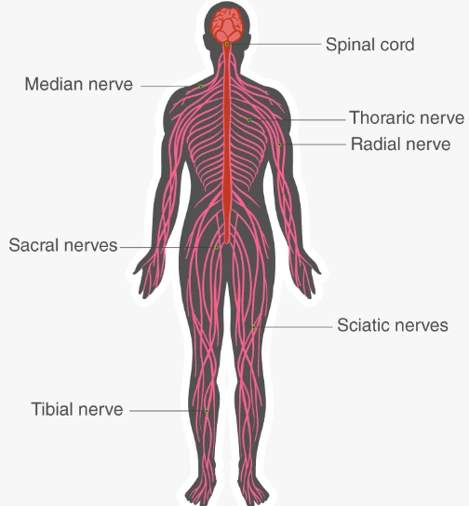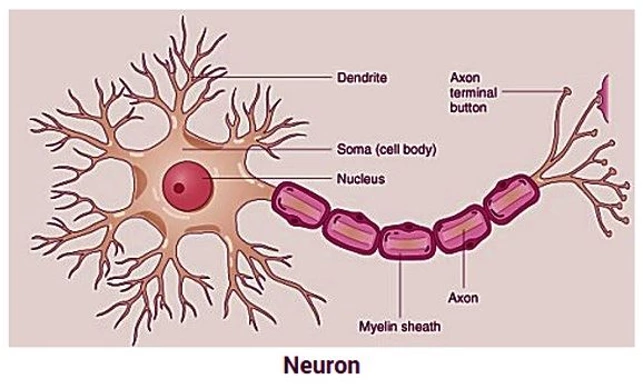Human Nervous System
Human Nervous System
Neuron Living life forms adjust to their positions and moves as an endeavor in light of the adjustments in nature for their bit of leeway or security. Any adjustment in the earth which makes a life form respond is called improvement, and the response or activity of the creature in answer to the react is called response . Some well-known stimuli are light, solid, heat, taste, smell, water, gravity and air.
Envision having a cracked bone or consume your finger, yet without the impression of torment. Without a doubt, it sounds perfect and a remarkable superpower, yet from an endurance point of view, it could be unfortunate.
The reaction to any improvements is a trademark conduct and property of the living creatures and responds to boosts with the assistance of the Nervous framework. The sensory system is an organ framework which is answerable for sending messages from the mind and spinal line to every one of the pieces of the body and back to the cerebrum. The fundamental sign in the unit of the sensory system is the Neuron.
Agony is the body's method for telling us that something isn't right. It can forestall further wounds or push us to look for restorative consideration. In addition, the entirety of this is conceivable in light of the fact that people can react and respond to improvements because of control and coordination among the different organs and organ frameworks.
Control and Coordination in basic multicellular creatures occur through just the Nervous framework which facilitates exercises of our body. It is the control framework for every one of our activities, thinking, and conduct.
What is the Nervous System?
The sensory system or the neural framework is a perplexing system of neurons specific to convey messages. The intricacy of the sensory system increments as we move towards higher creatures.
For example, cnidarians, for example, jellyfish have generally basic nerve nets spread all through their body. Crabs have a progressively entangled sensory system as 2 operational hubs called dorsal ganglion and ventral ganglion.
As we move further up the stepping stool, higher living beings, for example, vertebrates have built up the mind. Additionally, it is one of the most muddled structures in the set of all animals, containing billions of neurons, all complicatedly associated.
In the human body, the neural framework incorporates the exercises of organs dependent on the improvements, which the neurons recognize and transmit. They transmit messages as electrical driving forces and pass on messages to and from the sense organs. Accordingly, the apprehensive coordination includes the interest of the sense organs, nerves, spinal rope, and cerebrum.
Human Nervous System

Diagram of the Human Nervous System
One of the most unpredictable organ framework to ever develop, the human sensory system comprises of two sections, to be specific:
1. Central Nervous System (comprises of the cerebrum and spinal string)
2. Peripheral Nervous System ( incorporates every one of the nerves of the body)
Focal Nervous System
Focal Nervous System (CNS) is regularly called the focal preparing unit of the body. It comprises of the cerebrum and the spinal string.
Mind
The mind is one of the significant, biggest and focal organ of the human sensory system. It is the control unit of the sensory system, which encourages us in finding new things, recalling and understanding, deciding, and much more. It is encased inside the skull, which gives frontal, sidelong and dorsal insurance. The human cerebrum is made out of three significant parts:
1. Forebrain: The front piece of the mind, comprises of Cerebrum, Hypothalamus and Thalamus.
2. Midbrain: The littler and focal piece of the brainstem, comprises of Tectum and Tegmentum.
3. Hindbrain: The focal area of the cerebrum, made out of Cerebellum, Medulla and Pons.
Spinal Cord
The spinal line is a round and hollow heap of nerve strands and related tissues encased inside the spine and associate all pieces of the body to the cerebrum. It starts in continuation with the medulla and expands downwards. It is encased in a hard enclosure called vertebral section and encompassed by films called meninges. The spinal line is worried about spinal reflex activities and the conduction of nerve motivations to and from the cerebrum.
Peripheral Nervous System
Peripheral Nervous System (PNS) is the horizontal piece of the sensory system that creates from the focal sensory system which associates various pieces of the body with the CNS. We do both deliberate and automatic activities with the assistance of fringe nerves.
PNS incorporates two sorts of nerve fiber
1. Afferent nerve fibers – These are liable for transmitting messages from tissues and organs to the CNS.
2. Efferent nerve fibers – These are liable for passing on messages from CNS to the relating fringe organ.
Physical neural framework (SNS): It is the neural framework that controls the deliberate activities in the body by transmitting driving forces from CNS to skeletal muscle cells. It comprises of the substantial nerves.
Autonomic neural framework (ANS): The autonomic neural framework is engaged with automatic activities like guideline of physiological capacities (absorption, breath, salivation, and so forth.). It is an automatic framework which passes on the driving forces from the CNS to the smooth muscles and automatic organs (heart, bladder and understudy). The autonomic neural framework can be additionally separated into:
1. Sympathetic sensory system
2. Parasympathetic sensory system

A Neuron is an organized and utilitarian unit of the sensory system and dissimilar to different cells, neurons are sporadic fit as a fiddle and ready to direct electrochemical signs. The various pieces of a neuron are examined underneath.
• Dendrite loosens up from the cell body of a neuron, and it is the most limited fiber in the cell body.
• Axon is the longest string on the phone body of a neuron and has a protecting and defensive sheath of myelin around it.
• Cell body comprises of cytoplasm and core.
• Synapse is the minute hole between a couple of contiguous neurons over which nerve driving forces pass while moving from one neuron to the next.
Nerves
Nerves are string like structures that rise up out of the cerebrum and spinal line. It is liable for conveying messages to every one of the pieces of the body. There are three sorts of nerves. A portion of these neurons can fire signals at rates of more than 119 m/s or over 428 km/h.
1. Sensory nerves send messages from every one of the faculties to the mind.
2. Motor nerves convey messages from the mind to every one of the muscles.
3. Mixed nerves convey both sensory and motor nerves.
Cranial nerves start from the mind as these nerves convey driving forces to begin from the focal sensory system. Certain cranial nerves have a place with the gathering of blended nerves while certain ones fall under tactile nerves. Spinal nerves begin from the spinal rope. All the spinal nerves convey driving forces to and from the focal sensory system and these are a piece of blended nerves.


Similar Questions
Earthworm Excretory System and Nervous System Receptors
View Solution(a) What is the function of our nervous system ?
(b) What are the main organs of the human nervous system? Draw a labelled diagram to show the main organs of the human nervous system.
(c) How does the human nervous system work? Explain.
View Solution
Knowledge Check
The cytons of reflex in central nervous system and autonomal nervous system is
ASensoryBMixedCMotorDAll of theseIn mollusa, nervous system is represented by
AA paired nerve cordBA paired nerve cord with brain and cirumpharyngeal connectivesC3-4 paired gangliaDPrimitive brain and nerve cord.
Neural System OF Nervous System || Lower Animal Groups || Human Neural System Out lines
View SolutionHuman Brain (मानव मस्तिष्क)|Spinal Cord (मेरुरज्जु)|Neuron (न्यूरॉन)|Autonomic Nervous System And Peripheral Nervous System (स्वायत्त तंत्रिका तंत्र एवं परिधीय तंत्रिका तंत्र)|OMR
View SolutionFrog -Circulatory-system || Nervous System & Sense-organs
View SolutionNervous System|Types Of Nervous System|Human Brain|Fore Brain|Mid Brain|Hind Brain
View Solution(cockroach) Nervous system || Endocrine system
View SolutionClosed Circulatory System|Excretory System|Nervous System
View Solution
